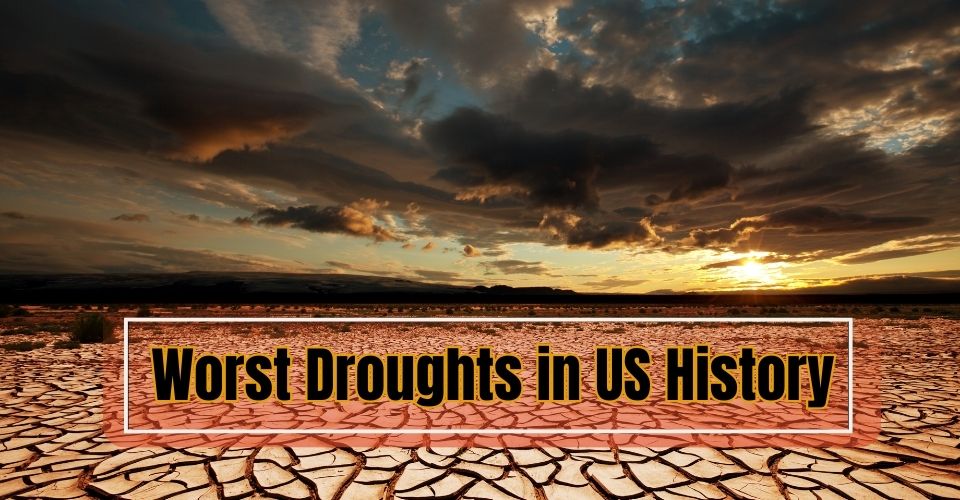Worst Droughts in US History: What We Can Learn from Them? [List]
Which are the worst droughts in US history? From the Middle Ages to today, the United States has experienced several extremely dry periods. Let’s explore the toplist below to see how damage it has caused in the past.

Which are the worst droughts in the US history?
- What Is a Drought?
- Droughts in the United States
- Top Worst Droughts in US History
- Medieval droughts
- 16th-century megadrought
- The Dust Bowl
- The 1950s Texas drought
- Northeastern drought
- Devastation in 1988
- 2012 - 2013 North American drought
- Which States Were Affected by Drought the Most?
- How to Prepare for a Drought?
What Is a Drought?
Drought refers to a deficiency of precipitation over an extended period, resulting in a water shortage.
This is a type of extreme weather that can impact the environment in many ways.
There are 5 main types of drought: Meteorological drought, Hydrological drought, Agricultural drought, Socioeconomic drought, and Ecological drought.
Drought can occur in the US, the UK, or anywhere.
.jpg)
Drought can occur in any environment worldwide
Droughts in the United States
The United States has been experiencing severe to extreme drought recently, according to the U.S. Drought Monitor.
Here are several statistics of droughts and effects in the US:
-
Between 1895 and 2010, about 14% of the United States experienced severe to extreme drought (classified as D2–D3) each year.
-
The most prolonged drought periods occurred during the 1930s, the 1950s, and the early 2000s.
-
Among these, the Dust Bowl of the 1930s stands out as the most significant drought and extreme heat event in U.S. history.
-
Over the past century, drought‐related crop failures and associated economic damages in the United States have reached several hundred billion dollars, with losses totaling $249 billion since 1980.
-
A 2017 case study in California found that an increase of approximately 100 drought-related news stories over a two-month period was linked to an 11% to 18% decrease in average household water use.
The risk of droughts has increased and threatens the environment and many national issues, such as food security.
Top Worst Droughts in US History
Dry conditions become more common in central North America and the US Southwest due to climate change.
However, this extreme weather has been common throughout US history.
Let’s explore the top worst droughts in the US.
Medieval droughts
In 1994, geographer Scott Stine found evidence of two major medieval droughts in California: one lasting 200 years before A.D. 1112, and another lasting 140 years before 1350.
These were part of a broader series of megadroughts (800–1400) that impacted the American Southwest.
Scientists believe they were driven by increased solar radiation, North Atlantic warming, and repeated La Niña events, and likely contributed to the collapse of several civilizations.
.jpg)
Medieval droughts
16th-century megadrought
In the 16th century, a prolonged megadrought affected North and Central America and may have played a key role in the failure of early European settlements.
At Jamestown, Virginia, resource shortages linked to the drought led to widespread malnutrition and contributed to high population losses between 1607 and 1624.
Tree-ring studies also suggest the same drought may have led to the disappearance of the Roanoke Colony and the abandonment of the Spanish settlement of Santa Elena.
.jpg)
Tree rings can tell us about drought times from centuries ago
The Dust Bowl
The Dust Bowl (1930–1936), also known as the "dirty thirties," was one of the worst U.S. natural disasters of the 20th century.
Severe droughts struck south-central states like Colorado, Oklahoma, Texas, Kansas, and New Mexico.
Poor soil management worsened the crisis, leading to massive dust storms( called “dusters" or "black blizzards") that swept across the Great Plains.
The Dust Bowl stands out due to its massive economic devastation, severe dust storms, widespread crop failure, and public health crises caused by dust inhalation (often referred to as "dust pneumonia")
-
Millions of acres of farmland were destroyed.
-
Over 2.5 million people were displaced, many becoming "Dust Bowl refugees" who migrated westward, especially to California.
-
Thousands experienced respiratory illnesses, and health complications from dust exposure placed heavy strain on communities.
-
Combined with the Great Depression, it resulted in severe economic hardship and widespread food insecurity.
.jpg)
Dust Bowl in the US
The 1950s Texas drought
Between 1950 and 1956, the Great Plains and U.S. Southwest experienced extreme heat and low rainfall.
Texas got a 40% drop in rainfall between 1949 and 1951, and crop yields were cut in half in some areas, according to the Texas Water Resources Institute (TWRI).
Farmers struggled to feed livestock, sometimes resorting to burning spines off cacti for feed.
Water rationing and conservation measures were implemented in over 1,000 towns and cities throughout the decade.
.jpg)
The 1950 Texas drought lasted for 7 long years
Northeastern drought
From 1962 to 1966, a major drought affected much of the northeastern U.S, including New York City.
There were 2 main causes for this drought:
-
Temperatures were lower than average
-
The rainfall was abnormally low
This drought led to heavy water deficiency, which a water conservation kicked into gear in New York City.
In 1965, journalist Robert Cantwell reported in Sports Illustrated magazine that "By this summer it was not surprising that a blimp bearing the ominous sign SAVE WATER was cruising over the otherwise cloudless skies about New York; that the city restaurants did not serve water unless patrons specifically asked for it; that fountains were turned off,".
.jpg)
Sprinklers worked overtime during the drought in 1964
Devastation in 1988
The 1987–1989 drought impacted 36% of the U.S. and caused an estimated $39 billion in damages.
The northern Great Plains were hardest hit, along with parts of the West Coast and the Northwest.
The drought also fueled widespread wildfires, including the burning of nearly 794,000 acres in Yellowstone National Park in 1988, leading to the park’s first full closure.
.jpg)
The drought of 1987 to 1989 in the US
2012 - 2013 North American drought
The 2012–2013 North American drought, an extension of the 2010–2013 Southern U.S. drought, was triggered by a severe heat wave and low winter snowfall. Intensified by La Niña, the drought spread northward, severely impacting crops and water supplies across the region.
The drought covered more areas in the US and Canada. In July 2012, the drought covered more than 81% of the area.
Through 2023, drought extended to parts of North America.
Till March 2013, rainfall lessened dry conditions in the Midwest, the southern Mississippi Valley, and the Great Plains.
.jpg)
The drought areas in the United States
Which States Were Affected by Drought the Most?
While western U.S. states often come as the most vulnerable to drought due to heat, dryness, and wildfires, a NOAA-funded study reveals that vulnerability depends on more than just rainfall.
It combines a state’s sensitivity, exposure, and ability to adapt to drought impacts.
These maps show each US state’s overall drought vulnerability and how it ranks in 3 categories: sensitivity, exposure, and ability to adapt.
-
Sensitivity ( blue): The potential for negative economic impacts. It is determined by factors such as the proportion of agricultural land, the number of livestock, the state’s dependence on hydropower, and recreational lakes.
-
Exposure (yellow and orange): The exposure index measures how frequently a state faces drought and what vulnerable assets (such as population size and freshwater ecosystems) are at risk during those events.
-
Ability to adapt ( purple): This score assesses how effectively a state can manage and recover from drought. It is based on factors like the drought response plan, irrigation capacity, and overall financial ability.
.jpg)
The U.S. drought vulnerability rankings
How to Prepare for a Drought?
Drought can last from several weeks to years, causing significant impacts.
Thus, people who live in a drought-prone area need to know essential drought safety tips to overcome this disaster.
What can I do to prepare for a drought? Here are some suggestions:
-
Conserve water: Install water-efficient appliances, reuse water for multiple purposes, install a rain catch system,...
-
Prepare your livestock: stock up on food supply early, prepare cool, ventilated places to help animals survive high temperatures and dry heat.
-
Install a rain catch system: This is a good idea to reuse rainwater for the irrigation of crops.
-
Rotate crops: Rotating your crops keeps your soil balanced. You can retain soil moisture by keeping a compost pile year-round to lay on top of the soil, planting crops closer together, and layering with mulch.
-
Repair any leaks: Find the leak and repair it as quickly as possible.
-
Invest in energy-efficient appliances: Invest in high-efficiency dishwashers, washing machines, and toilets to conserve both water and energy throughout the year.
.jpg)
Ways to prepare for a drought
Conclusion
The worst droughts in US history led to major challenges including crop failures, public health concerns, and economic downturns...From the above toplist, hope you know how droughts damage, and then raise awareness of water conservation, and have a preparation plan to face this disaster.
Frequently Asked Questions (FAQs)
◎ Wore goggles to protect eyes from blowing dust.
◎ Hang wet sheets in windows to catch dust particles.
◎ Sealed windows and doors with adhesive tape or mud to block dust.
◎ Migrated to other regions, especially the West, in search of better living conditions.
◎ Implemented soil conservation practices: planting trees as windbreaks, contour plowing, and crop rotation.

![10+ Hottest Cities in the US Ranked, Based on Temperature [UPDATED] 10+ Hottest Cities in the US Ranked, Based on Temperature [UPDATED]](https://assets.weather365.com/images/1751539318_hottest-cities-in-the-us-1.jpg)

![5 Types of Drought & Their Impacts on Human Activities [Explained] 5 Types of Drought & Their Impacts on Human Activities [Explained]](https://assets.weather365.com/images/1751539051_types-of-drought-1.jpg)

0 Comment
Leave a comment
Your email address will not be published. Required fields are marked *